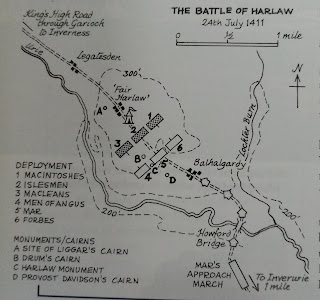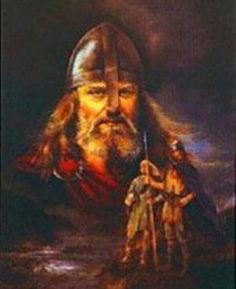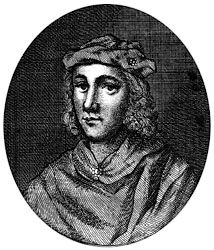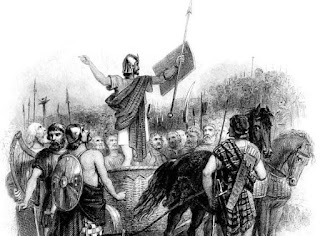The Battle of Harlaw
BATTLE OF HARLAW.
Famed in ballad, the Battle of Harlaw was the first great conflict between Lowland and 'Highland' Scotland. The battle itself was over the ownership of the Earldom of Ross, claimed for the Highlands by Donald, second Lord of the Isles. Opposing him was the Lowland Stewart dynasty under the Duke of Albany.
Armed conflict was the only option as King James I, who might have been able to arbitrate, was being held captive in England.
Donald, who regarded himself as an independent ruler, had English help. He was probably also supported by the captive Scottish king, who was increasingly dismayed at the waywardness of his Stewart relatives.
Although Donald's real purpose was to secure the eastern lands of the Earldom of Ross, he seems to have planned to pillage Aberdeen and th surrounding area as a means of weakening the Stewart earls. The power and prestige of the Lord of the Isles at that time was shown by the size of Donald's army at Harlaw - perhaps as many as 10,000 men.
Defending Aberdeen on the Lowland side was Alexander Stewart, Earl of Mar, one of the more colourful figures in Medieval Scottish History.
The young Mar demonstrated a reckless savagery reminiscent of his father, the infamous Wolf of Badenoch. In his more mature years, however, he mellowed to reveal a more capable and subtly ruthless character.
Around Christmas 1410, Mar entertained a large gathering of powerful north-eastern lairds and clergymen where preparations were probably made to defend Aberdeen against Donald.
As the Highland army advanced towards Aberdeen in spring 1411, the North-East took arms. Aberdeen itself, however, remained woefully unprepared. Out of a population of more than 3,000, only 36 citizens were called-up to defend the town.
After torching Inverness, Donald took the most direct route to Aberdeen, along the King's Highway, leaving Mar only three or four days co-ordinate his forces.
On the eve of the battle, Mar marshalled his several thousand troops around the Bass of Inverurie, about a mile south of Harlaw. Meanwhile, Donald arrived at Harlaw and camped on the elevated plateau to the north of the town.
At dawn, Mar's company broke camp and crossed the river Urie by the wooden bridge that had stood there since 1235. Lowland tradition makes the unlikely claim that the Highlanders were then surprised as they slept in their plaids and skins. It is possible that many of Donald's men were absent, foraging and looting the countryside.
A more reasonable assumption is that the Highlanders were mainly ready, springing into action 'like angry bees disturbed in their byke', when the alarm was raised.
The heads of both armies clashed near the summit of the ridge on which the present Harlaw Monument stands. The clans' charge forced the Stewarts' men to give ground. But in return, Mar's own division hurried forward, and with great effort held the line.
The fighting was 'hot and fierce' and the clans suffered terrible casualties. The Lowlanders may also have sustained unnecessarily heavy losses if Mar did indeed recklessly hurl fresh troops into the breach, as a later commentator believed.
During the battle individual bravery seems to have been more important than military strategy. The forces were equally matched, and morale must have been high on both sides to sustain what was a long and ferocious conflict.
When the sun rose on the bodies of the dead, the situation was a stalemate. The Lowlanders had held their ground, but the Highlanders were undefeated. Among the most notable losses were Lowlander Sir Alexander Irvine and Highlander Red Hector Maclean- who is believed to have fought an epic duel, by the end of which both lay dead.
It is said that, many years later, the successors of Irvine and Red Hector exchanged swords to mark an end of hostilities between them.
A key aspect of the Battle of Harlaw is that it marks the clear emergence of a cultural divide between Lowlander and Highlander.
Although Donald and Mar were related and Gaelic was spoken on both sides, it was the Lowlanders who were rewarded by the Scottish government for their efforts.
A Gaelic battle song, celebrating the bravery of the clans, says the Lowlanders were 'quite defeated and chased all the way to Aberdeen.
The Lowland version of events portrays Harlaw as a 'racial' war in which a mob of 'barbarous' Highlanders is driven back from the gates of Aberdeen by a 'civilised' Lowland army.
It is doubtful whether the Lowlanders were in fact any more 'civilised' than their Highland neighbours, and we have seen that they were certainly no less barbarous.
Today, the battlefield is easily reached by road from Inveruric, and is marked by the impressive but controversial Harlaw Monument. Unveiled in 1914, its dedication ignores those who died on the Highland side.
At Harlaw, Scotland's two cultural halves were too evenly matched for one to prevail against the other. But the battle also markedly increased tension between Lowlander and Highlander, profoundly affecting relations in later years.












Comments
Post a Comment